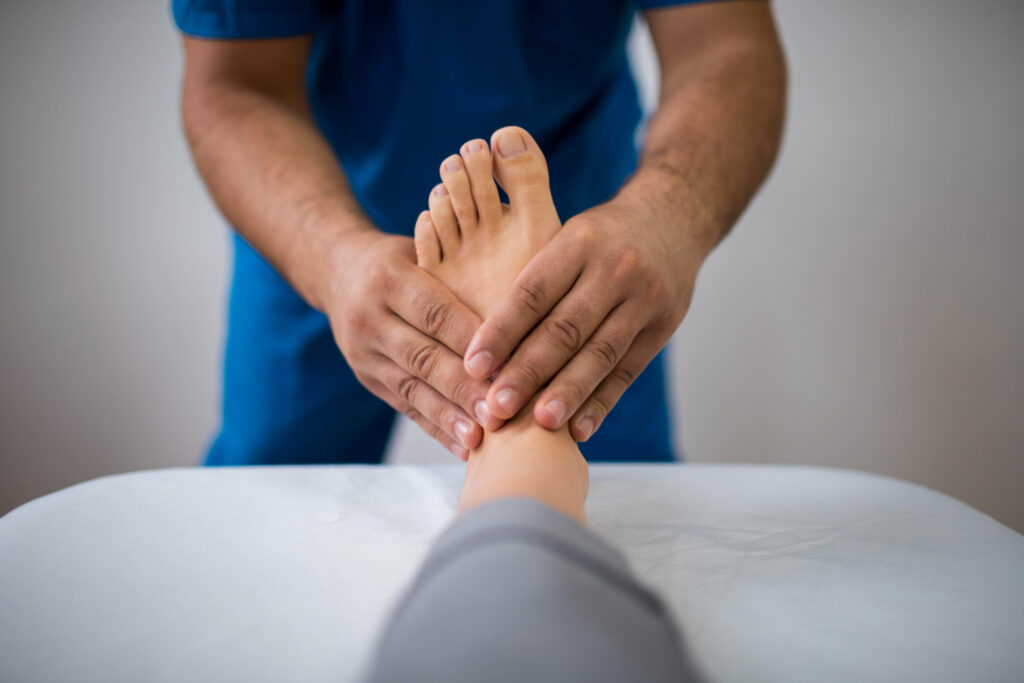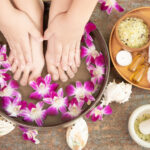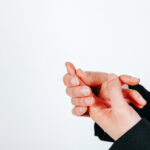
In this article
Athlete’s foot, or tinea pedis, is a fungal infection that affects the skin of the feet, particularly between the toes. This condition leads to inflamed, itchy, and scaly skin and can extend to the soles of the feet. Athlete’s foot thrives in warm, damp environments like locker rooms and swimming pools, making these common areas for transmission.
Treatment Options
Medical Professionals
Dermatologists, podiatrists, and general practitioners commonly treat athlete’s foot. Although over-the-counter (OTC) medications are typically effective, the infection often recurs. Topical antifungal treatments are preferred, but oral antifungals may be necessary in some cases. Reducing moisture in the affected area is crucial for prevention.
Medications
Healthcare providers usually recommend OTC topical antifungal medications to treat athlete’s foot. Oral antifungal drugs may also be prescribed for more severe or persistent cases.
Topical Antifungals:
Topical antifungal treatments, available as powders or creams, should be applied to the infected area once or twice daily for 1-6 weeks, depending on the severity and response to treatment. Common antifungal medications include:
- Lotrimin (clotrimazole)
- Spectrazole (econazole)
- Nizoral (ketoconazole)
- Monistat (miconazole)
- Exelderm (sulconazole)
- Trosyd or Gyno-Trosyd (tioconazole)
It’s essential to continue the treatment for 1-2 weeks after the infection clears to prevent recurrence. Topical antifungals are generally well-tolerated, though some users may experience mild itching or stinging.
Oral Antifungals:
Oral antifungal medications are prescribed if topical treatments fail, if the infection frequently recurs, or if it is severe. Common oral antifungals include:
- Diflucan (fluconazole)
- Grifulvin V or Gris-PEG (griseofulvin)
- Sporonax (itraconazole)
- Lamisil (terbinafine)
Oral treatments range from 1-8 weeks and may cause side effects like headaches, nausea, and itching.
Advanced Therapies
In cases where athlete’s foot spreads to the toenails, causing onychomycosis, a combination of topical and oral treatments may be used. Additional therapies include:
- Non-thermal plasma: Uses a cold laser to destroy fungal cells.
- Laser poration: Creates nail pores allowing deeper penetration of topical treatments.
- Photodynamic therapy (PDT): Involves a photosensitizer and light source to kill fungal cells.
These treatments may pose risks, such as liver damage, necessitating liver function tests before and during treatment.
Complementary and Alternative Medicine
Some natural remedies, though needing more research, are used to treat athlete’s foot:
- Red onion extract
- Tasmanian blue gum extract
- Lavender and lemongrass essential oils
- Tea tree oil
- Herbal foot baths
Lifestyle and Prevention
Preventing athlete’s foot involves maintaining proper foot hygiene and adopting specific habits:
- Choose breathable shoes: Opt for sandals or shoes made from natural materials like cotton and leather.
- Wear cotton socks: Wash socks in hot water to eliminate fungi.
- Thoroughly wash feet: Clean feet with soap and water twice daily and dry them thoroughly, especially between the toes.
- Boil affected clothing: Boil socks and other clothing to kill fungi.
- Avoid walking barefoot: Use shower shoes in public places.
- Use antifungal powders: Apply drying powders in areas where athlete’s foot is common, such as locker rooms.
- Keep toes dry: Use lamb’s wool padding between toes to maintain dryness.
Encourage household members to follow these practices to prevent the spread of the infection.
Living With Athlete’s Foot
Athlete’s foot affects 3-15% of people during their lifetime, with risk factors including physical activities, allergies, and circulation issues. Those with hyperhidrosis (excessive sweating) or a family history of the condition are more susceptible. While the infection is generally manageable with self-care and lifestyle adjustments, it won’t resolve without treatment and can spread to other body areas if left unchecked. Taking preventive measures is crucial for those prone to athlete’s foot
A Quick Review
Athlete’s foot, or tinea pedis, is a common fungal infection affecting the skin of the feet. It thrives in warm, damp environments like locker rooms and pools. Treatments include topical and oral antifungals, and lifestyle changes can prevent recurrence. Ensure proper foot hygiene to reduce risk
FAQS
What is athlete’s foot?
Athlete’s foot is a fungal infection that affects the skin on the feet, particularly between the toes.
How is athlete’s foot treated?
Treatment involves topical antifungal creams, oral medications, and maintaining dry, clean feet.
Can athlete’s foot spread to other parts of the body?
Yes, if left untreated, it can spread to other body areas like toenails, causing onychomycosis.
How can I prevent athlete’s foot?
Maintain proper foot hygiene, wear breathable shoes, use antifungal powders, and avoid walking barefoot in public places.
Are there natural remedies for athlete’s foot?
Some natural remedies include tea tree oil, red onion extract, and lavender essential oil, but more research is needed to confirm their effectiveness.











